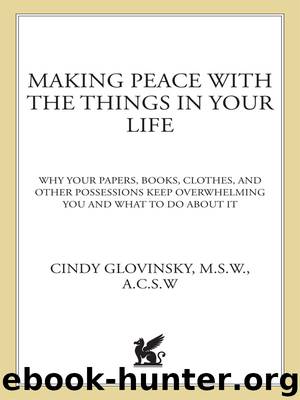Making Peace with the Things in Your Life by Cindy Glovinsky

Author:Cindy Glovinsky
Language: eng
Format: epub
ISBN: 9780312284886
Publisher: St. Martin's Press
SUBTROUBLE 5. FIGURE AND GROUND CONFUSION
(SELECTIVE ATTENTION PROBLEMS)
In almost any Psych 101 textbook, there’s a picture that can be looked at two different ways. From one mind-set, it looks like a vase, and from another, like two opposing faces. (Another version shows an old woman—or a young one.) To switch from one view to the other, you don’t need to turn the picture around or do anything with your eyes—only with your brain, which constantly makes decisions about what you will and won’t consciously see. You can flip from one to the other by doing something purely in your brain.
What you see depends on what you’re looking for. Children’s activity books often contain pictures in which certain objects are hidden among the details, and the child is asked to circle the ones he or she can see. To find a banana in the picture, Betty Brighteyes must have either a clear image of a banana or a list of banana criteria in her head. Bettys eyes scan the picture while her mind flips through images and criteria and compares them with what she sees until Presto! A match! This is called selective attention, and it plays a key role where sorting, organizing, and getting rid of Things is concerned.
Suppose Betty’s older sister, Barbie, is looking at her sweaters, knowing she needs to get rid of some of them. If Barbie’s brain is not selectively attentive, all of her sweaters will look exactly the same to her, and what she’ll see is merely an amorphous mass of colors. Although she may wear one sweater every day and not have worn others for months, in her mind one sweater is just as good as another: nothing leaps out at her. This makes it difficult for Barbie to decide what to keep and what to give away, which may cause her to throw up her hands and turn on the TV.
If a pile of Things seems totally amorphous to you, try the following:
• Review the lists in the introduction to Chapter 5 to clarify your criteria for keeping Things versus giving them away.
• Use sticky notes to put “grades” on the possessions you’re evaluating, A through F, according to how much they mean to you, and get rid of everything that ranks below a certain grade.
• Decide how many of these Things you can keep. Think of someone that you see as epitomizing normality, your doctor, perhaps, or your best friend’s husband, or the president of the PTO. How many of these Things would he or she have?
• Suppose you’ve decided to keep eight of these Things. Imagine your home is a store and you’re shopping. Choose eight to “buy” and get rid of the rest.
• Suppose you have to leave on a flight for Australia in two hours and need to make hasty decisions. Things will leap out at you.
• Focus on two Things and compare them. Which one makes you feel the best to look at? Which fits your criteria the best? Then compare a third Thing with the other two.
Download
This site does not store any files on its server. We only index and link to content provided by other sites. Please contact the content providers to delete copyright contents if any and email us, we'll remove relevant links or contents immediately.
The Body: A Guide for Occupants by Bill Bryson(4974)
Audition by Ryu Murakami(4850)
Adulting by Kelly Williams Brown(4487)
Housekeeping by Marilynne Robinson(4345)
Be in a Treehouse by Pete Nelson(3945)
Zero Waste Home by Bea Johnson(3777)
Seriously... I'm Kidding by Ellen DeGeneres(3577)
Better Homes and Gardens New Cookbook by Better Homes & Gardens(3525)
The Healing Self by Deepak Chopra(3474)
Barkskins by Annie Proulx(3312)
Hedgerow by John Wright(3275)
The Cellar by Natasha Preston(3260)
Spark Joy by Marie Kondo(3249)
The Genius of Japanese Carpentry by Azby Brown(3224)
The Life-Changing Magic Of Tidying Up- The Japanese Art Of Decluttering And Organizing (v5.0) by Marie Kondo(3211)
120 Days of Sodom by Marquis de Sade(3179)
Work Clean by Dan Charnas(3048)
The Book of Numbers by Peter Bentley(2912)
A Monk's Guide to a Clean House and Mind by Shoukei Matsumoto(2867)
